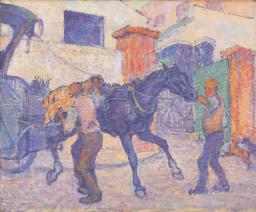Frank Rutter, ‘Round the Galleries’
Sunday Times, 25 June 1911, p.5.
ROUND THE GALLERIES
Neo-Romanticists?
It is curious how, when we try seriously to consider serious paintings, we find ourselves unconsciously drifting into the use of the old terms, classic and romantic. Last week in a preliminary survey of the first exhibition of the “Camden Town Group” at the Carfax Gallery (24, Bury-street, Jermyn-street) my allotted space was exhausted in mentioning those members who seemed naturally to group together by a salient common tendency, towards what may be conveniently, if loosely, summed up as classicism. Most of the remaining exhibitors may not unfairly be described as “romantics.” Surely the term is not altogether inapplicable to Mr. Spencer F. Gore, so deservedly elected President of the Group – who can see a decorative motif in a brass bedstead in “The Bed-Sitting Room” (24), and can extract a natural beauty of colour from the artificial splendour of a “Stage Sunrise” (27). Perhaps more correctly Mr. Gore might be termed a luminist who has applied the radiant vision of Monet and Pissarro and their vibratory technique not only to London streets, as in “Mornington Crescent” (25), and dwelling-rooms, but also to the stage of the Alhambra. His insistence on design in these ballet-impressions and in his other works links Mr. Gore to the sub-group already mentioned, and a similar insistence on decorative arrangement characterises the paintings of Mr. Lucien Pissarro and Mr. Robert P. Bevan. Romantic – and luminist bien entendu – are the Colchester landscapes (13, 14, 16) of Mr. Pissarro, but another adjective is required to do justice to his “Well Farm Bridge, Acton” (15), which attains the epic in its expressive rendering of the train thundering under the bridge. This is a painting which, both for its intrinsic interest and as a shining example of luminist principles happily applied, ought to be purchased for the nation. The Contemporary Art Society prides itself, I understand, on acquiring works for the nation some time before the nation is ready to receive and appreciate them, and I trust the society will make the most of the rare opportunity afforded it by the exhibition of the Camden Town group. I am sure the nation will be ready to receive and appreciate Mr. Pissarro’s “Well Farm Bridge” long before it takes kindly to the sculptures by Mr. Gill which the society has already purchased.
The Vanishing Cab Horse.
Further, I would commend to the notice of this society the works of Mr. R. P. Bevan, who is one of the hardest of the group to place by reason of his strong individuality. His decoratively conceived and shrewdly observed paintings of the vanishing cabhorse in street and stable (28, 29, 31) are in some respects the most remarkable pictures in a remarkable exhibition. To their great and obvious artistic merits they have added a genuine historic interest, and they are precious documents of rapidly disappearing phases of London life. Mr. Bevan is a true heir to Hogarth and Rowlandson, and I have no doubt whatever that his temperamental studies of his own times will be as sought after by future generations as those of Hogarth and Rowlandson are to-day. Sane originality and distinction characterise the works of three deeply interesting painters, Mr. Harold Gilman, Mr. Charles Ginner, and Mr. Malcolm Drummond. Mr. Gilman’s two portraits (53, 55) are hallmarked by his uncompromising sincerity and firm grasp of form, while his delicate sense of colour and reverent handling of pigment are also revealed in his little “Snow Scene” (52), lines of washing hung out in winter. Making due allowance for the difference between the gravity of a northerner and the more ardent temperament of a son of the south, we find kindred qualities in the work of Mr. Ginner, who, as befits a native of Provence, excels in rendering strong hot sun effects (36, 39). Even in his evident London still life – which has the solidity without the brutality of a Cézanne – there lingers a glow of the southern sun. All Mr. Drummond’s contributions are interesting, for he is an admirable colourist with a keen feeling for form and design, but he is perhaps seen at his best in “Paddington Station” (46), admirable alike in its main design and in its happy suggestion of the bustle of a great station. Pleasant luminist landscapes are also shown by J. B. Manson and W. Ratcliffe, the two newest recruits to the group, whose works, like all the other paintings in this collection, have engaging qualities of colour and surface.
How to cite
Frank Rutter, ‘Round the Galleries’, in Sunday Times, 25 June 1911, p.5, in Helena Bonett, Ysanne Holt, Jennifer Mundy (eds.), The Camden Town Group in Context, Tate Research Publication, May 2012, https://www

